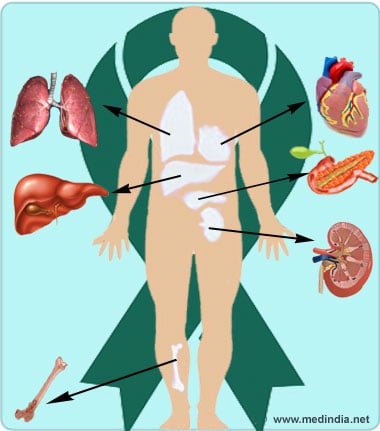- An Update on Immunosuppressive Medications in Transplantation - (http://www.fmshk.org/database/articles/897.pdf)
- Informed Consent in Living Organ Donors - (http://www.biology-online.org/articles/informed_consent_living_organ.html)
- Transplant rejection - (http://www.nlm.nih.gov/medlineplus/ency/article/000815.htm)
- Recovery of transplantable organs after cardiac or circulatory death: Transforming the paradigm for the ethics of organ donation - (http://www.peh-med.com/content/2/1/8)
- Presumed Consent or Mandated Choice to Overcome Organ Shortage - (http://www.mohanfoundation.org/organ-donation-transplant-resources/presumed-consent-mandated-choice-overcome-organ-shortage.asp)
- Immunosuppressive drugs - Snell GI, et al. Everolimus versus azathioprine in maintenance lung transplant recipients: an international, randomized, double-blind clinical trial. Am J Transplant 2006; 6:169.
- Immunosuppressive drugs - Kawai, Tatsuo et al. HLA-Mismatched Renal Transplantation without Maintenance Immunosuppression. N Engl J Med 2008 358: 362-368. Volume 358:362-368, January 24, 2008, Number 4.
- Immunosuppressive drugs - E K Geissler and H J Schlitt. Immunosuppression for liver transplantation. Gut 2009; 58; 452-463; originally published online 3 Dec 2008;
- Chouhan P and H Draper. Modified Mandated Choice for Organ Procurement J Med Ethics. 2003;29(3):157-162, at p. 158.
What is organ and tissue transplantation?
Organ transplantation is the replacement of a non-functioning organ with a functioning organ. The functioning organ can be donated either by a living person or taken from a deceased (or cadaver) body. The organs that are transplanted are usually organs that contribute towards a critical function for continuation of life. Some of the organs that can be donated and transplanted are heart, liver, kidneys, lungs, pancreas and intestines.
Similarly tissues can also be transplanted. Common tissues which can be donated and transplanted include heart valves, corneas (eyes), bones, bone marrow, tendons, middle ear bones and skin.

It is only when organs have suffered incurable functional damage that cannot be cured by drugs or any kind of surgical treatment that the are treated by
What are the types of transplantation?
There are two types of transplantation; namely, living and cadaveric transplantation (from a deceased donor).
In a living-related transplantation, a person donates an organ (e.g. one kidney), or part of an organ (e.g. part of liver) to a patient. The person who donates can either be a relative or be emotionally related or be a unrelated donor.
In a cadaveric transplantation, the organs are obtained from a person who has sustained a brain death. Cadaveric transplantation is the predominant means of organ transplantation in many countries like the United States of America and most European countries. In the Asian region South Korea, Kuwait, Thailand, Taiwan, Hong Kong, Singapore and India are pushing forward such an initiative
What is transplant rejection?
There are two possible risks for complications in transplant surgery. One is infection and the other is transplant rejection. ‘When a transplant recipient''s immune system attacks a transplanted organ or tissue,’ it is called a transplant rejection. Drugs to suppress the immune system (
History of organ transplantation
The first reasonable account of transplantation comes from as early as 2nd century BC by the Indian Ayurveda surgeon Sushruta, who used autografted (a tissue or organ that is transplanted from one part to another of the same body) skin transplantation in nose reconstruction rhinoplasty. However, success or failure of these procedures is not well documented.
In the 16th century, the Italian surgeon Gasparo Tagliacozzi performed successful skin autografts, but he failed consistently with allografts (different donor) offering the first suggestion of rejection mechanism. He came to be known as the father of plastic surgery.
In 1905, the first successful human corneal transplant was performed by Eduard Zirm in Czech Republic.
In 1955 Joseph Murray and J. Hartwell Harrison performed the first successful kidney transplant between identical twins – successful because no immune suppression was necessary in genetically identical twins. Joseph Murray was awarded the Noble Prize for his success.
In 1967, Christiaan Barnard performed the first successful heart transplant in Cape Town, South Africa. Louis Washkansky, the recipient, survived for 18 days. Given below are some other important successful firsts in transplantation history–
- 1962: Kidney transplant from a deceased donor by Joseph Murray and David Hume in Boston.
- 1963: Lung transplant by James Hardy at the University of Mississippi Medical Center in Jackson.
- 1966: Pancreas/kidney transplant by Richard Lillehei and William Kelly at the University of Minnesota in Minneapolis.
- 1967: Liver transplant by Thomas Starzl at the University of Colorado in Denver.
- 1983: Single lung transplant by Joel Cooper at Toronto General Hospital in Canada.
- 1986: Double-lung transplant by Joel Cooper at Toronto General Hospital in Canada.
- 1989: Small intestine transplant from a deceased donor into a child, by Olivier Goulet in France.
- 1989: Living-related liver transplant by Christoph Broelsch from Hamburg, Germany, at the University of Chicago Medical Center.
- 1990: Living-related lung transplant from a mother to her 12-year-old daughter by Vaughn Starnes in California.
- 1992: Baboon to human liver transplant by Satoru Todo, Andreas Tzakis and John Fung, under the direction of pioneer transplant surgeon Thomas Starzl, at the University of Pittsburgh Medical Center.
- 1998: Hand transplant led by Australian surgeon Earl Owen and French surgeon Jean-Michel Dubernard in France.
- 2005: Partial face transplant for a 38-year-old woman, who was mauled by her dog. Surgery was performed by Bernard Devauchelle and Jean-Michel Dubernard in Amiens, France.
- 2010: The world’s first full face transplant took place in Spain by the doctors at Vall d''Hebron Hospital in Barcelona.






